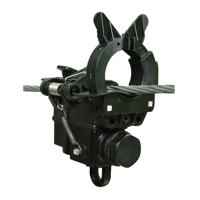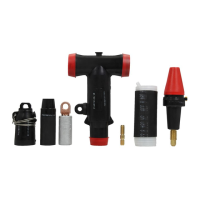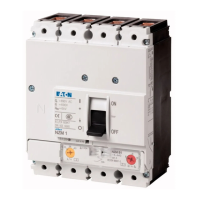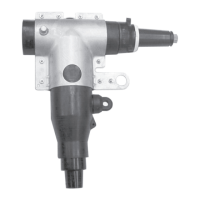Type VSA12, VSA16 and VSA20/800 maintenance instructions
6MAINTENANCE INSTRUCTIONS MN280064EN October 2017
1. If the recloser passes the closed contacts tests
(Tests1 and 2) but fails the open-contacts test (Test
3) a deteriorated vacuum in one or more of the
interrupters is most likely the cause. Retest each
vacuum interrupter individually to determine the failed
phase or phases, and replace the interrupter(s). Retest
to confirm the repair.
2. If the recloser fails the closed-contacts tests
(Tests 1and 2) the cause is likely to be a diminished
electrical clearance or a failed insulation. After
correcting the problem, retest to confirm the repair.
Shop maintenance instructions
The operations described in this section should be
performed under the cleanest conditions possible. No
special tools are required for any of the repair procedures.
Bushings
Bushing maintenance generally consists of a thorough
cleaning and a careful examination for chips, cracks or
other physical damage during the periodic maintenance
inspection. Bushing porcelain must be replaced whenever
damage is discovered. The porcelain can be replaced
without removing the bushing assembly from the recloser.
To replace bushing porcelain proceed as follows, refer to
Figure 7:
1. Unscrew the bushing terminal, discard the
terminal gasket.
Bushing
terminal
Terminal
gasket
Bushing
porcelain
Roll pin
Bushing rod
Hex nuts
Bushing
clamps
Split ring
Lower
gasket
Figure 7. Bushing porcelain replacement
2. Remove the three hexnuts and bushing clamps that
secure the bushing to the recloser housing.
3. Remove and discard the lower bushing gasket.
4. Twist off the split aluminum ring from the old bushing
and install on the new bushing porcelain, if it is still in
good condition; replace if damaged.
CAUTION
Bushing damage. The split aluminum ring must be
replaced if damaged. The clamping ring cushions and
distributes the pressure between the bushing flange and
the bushing. If bushing clamps are assembled without a
new clamping ring, the bushing may be damaged when
clamp hardware is tightened.
T234.1
5. Install a new lower bushing gasket and slide the new
bushing porcelain, into the recloser housing, over the
bushing rod. Make sure that the roll pin is seated in the
locking groove in the top of the bushing.
6. Position the clamping ring with the split centered
between two clamp bolts.
7. Install bushing clamp hardware and tighten nuts evenly,
a little at a time, to 6-10 ft-lbs. torque.
CAUTION
Dielectric failure, bushing damage. To prevent gasket
leaks or bushing damage, clamping force must be applied
gradually and equally in rotation to each bolt. If the
clamping force is not evenly applied, seal leakage can
result, compromising the dielectric capabilities of the
recloser and can cause possible personal injury. Unequal
clamping force can cause bushing breakage.
T235.2
8. Apply a very small amount of petroleum jelly to the
knurled inside surface of the bushing terminal.
9. Install a new terminal gasket and the bushing terminal,
tighten to 35 ft-lbs. torque.
Vacuum interrupters
Vacuum interrupters must be replaced when:
They lose their vacuum as evidenced by a failure during
the low-frequency dielectric withstand test across the
open contacts; or
The interrupter contacts have eroded beyond their useful
life as evidenced by the position of the scribe mark on
the moving contact rod.
To replace an interrupter refer to Figure 8, and proceed
asfollows:
1. Remove fused pullout switch to de-energize AC power
source to operator mechanism.
2. Make sure recloser contacts are open; manually
operate mechanism until contact position indicator
reads OPEN and closing spring status indicator reads
SPRINGS DISCHARGED.
3. Remove nylon hardware, or wire tie, securing insulating
barrier to stringers, remove insulating barrier.
4. Remove hardware and clamp that secure long bushing
rod to lower interrupter support bracket.

